Greetings everybody,
Today’s edition of The Sewing Machine Newsletter is inspired by Mr. Paul Skallas. He’s best known LindyMan on Twitter, where he posts tweets about the Lindy Effect and observes the world through a Lindy-colored lens. He also writes a fantastic newsletter I highly recommend called The Lindy Newsletter.
The Lindy Effect suggests that the future life expectancy of an idea, technology, or concept is proportional to its current age. Or, in other words, the longer something has been around, the longer it's likely to remain relevant and in use. Think of a play on Broadway. According to the Lindy Effect, the longer a show has been running, the longer it is likely to continue running. For example, Wicked has been running since 2003. Because it has running for so long, it is likely to continue running for the next few years, whereas a new Broadway show that opened last week is less likely to run for the next few years.
Another example: people have been drinking wine forever. The Lindy Effect says that because wine has been around for thousands and thousands of years, it will continue to be around for many years to come. Meanwhile, something like vaping is a relatively new phenomenon. The first e-cigarette appeared in 2003. If we imagine the world 100 years from now, it is much easier to imagine a world with wine and without vapes, rather than the inverse. It would be very surprising if, 100 years from now, wine has fallen by the wayside. On the other hand, if vapes are no longer being used 100 years from now, that would be far less surprising.
LindyMan takes this concept of the Lindy Effect and uses it as a substrate to develop a wider worldview. By classifying things in the world as “Lindy” or “not Lindy” , one could theoretically lean into that which is Lindy and live a Lindy lifestyle.
What makes something Lindy?
Generally speaking, something can be classified as Lindy if it has been around for 500+ years.
For example, archaeologists trace coffee back to about 800 A.D. Since it is over 1,000 years old, coffee is Lindy. Energy drinks (Monster, Red Bull, etc.) have been around for less than 100 years. Not Lindy at all. If we want to live a Lindy lifestyle, coffee over Redbull is the obvious choice when choosing which beverage to derive energy from.
Another example: Walking outside and exposing yourself to sunlight is Lindy; modern office jobs, which aren’t Lindy, result in people getting out into the sun as much as they once did.
MORE EXAMPLES
NFT’s - not Lindy
Cash - Lindy
Wine - Lindy
Tobacco - Lindy
Books - Lindy
Television (1927) - Not Lindy
Theatre - Lindy
Wrestling - Lindy
Basketball (1891) - Not Lindy)
Ketchup (1812) - Not Lindy
Mayonaise (1756) - Not Lindy
Mustard (3000BC) - Lindy
Tattoos - Lindy
Wigs - Lindy
Christianity - Lindy
Judaism - Lindy
Islam - Lindy
Scientology - Not Lindy
Things that are Lindy are not necessarily good in themselves. War is Lindy. Infant mortality is Lindy. Obviously, those are two horrible, ancient things. I am personally drawn to the Lindy Effect because I think the concept can be highly useful. If X is Lindy, then there are reasons why X has been able to last over time, and we can analyze those reasons and learn from them. If a thing has been around for 5,000 years, then there just might be something about that thing that is worth noting. The opposite sentiment may be equally true.
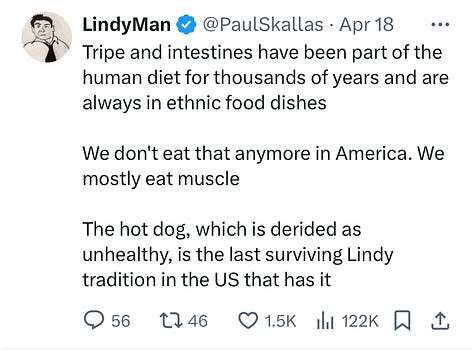
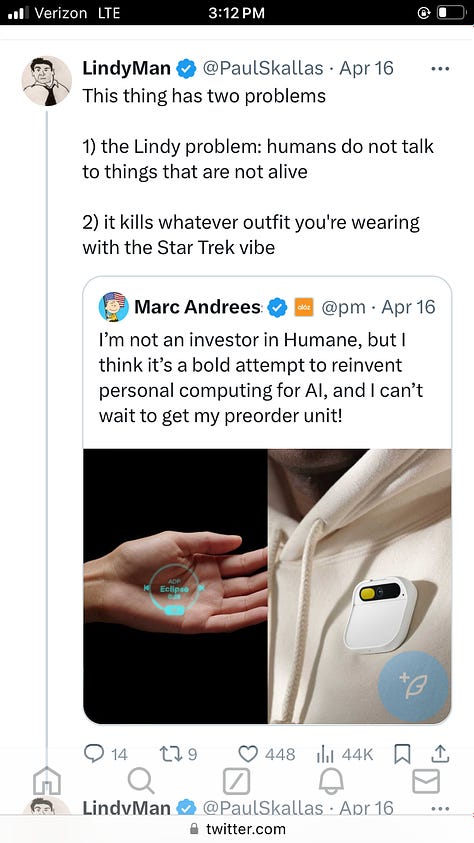

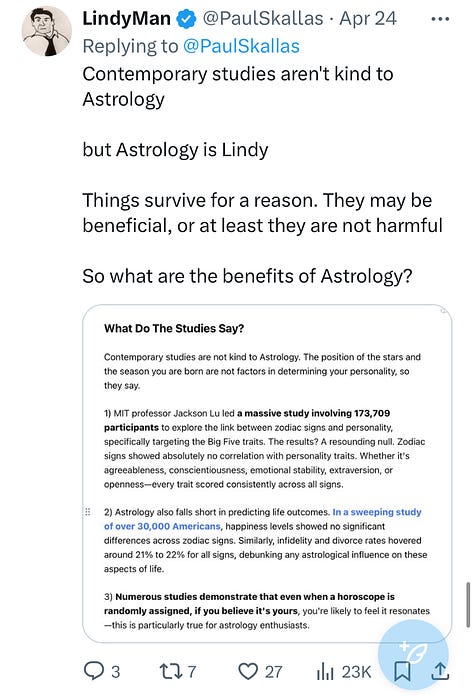

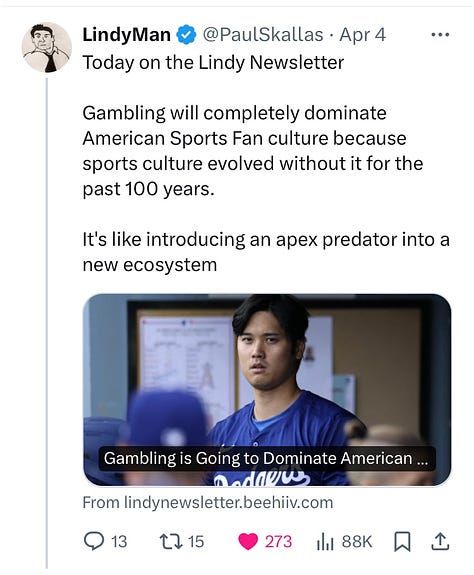
Lindy Bets
Some things exist today that are not technically Lindy, but one day will become Lindy because they have lasting power. A fun mental exercise is to take two popular things today and make a “bet” of which one has a better chance of becoming Lindy. Between X and Y, which one has more lasting power?
For example, ketchup was invented in 1812— not Lindy. Mayonnaise was invented in 1756— also Not Lindy. Let’s say, that 300 years from now, one will still be in use and the other will not. Which would you bet will still be around? Which has a better chance of becoming Lindy?
You could do the same thing with cars (1886), airplanes (1903), and trains (1804). Let’s say that 400 years from now, one of these three modes of transportation will still be in use, while the other two fall by the wayside. Which one becomes Lindy?
20 years ago, you could have done the same thing with headphones vs the CD-ROM. Myspace vs Facebook. Phone booths, iPods, VCR’s and VHS, floppy discs, etc. When these things first came into existence, they might have appeared to be significant inventions. Some people would have fairly assumed that they would be around for hundreds of years. Instead, they were short lived.
You probably see where I am going with this. . . . . . .
Are sewing machines Lindy?
There is much controversy about when the first sewing machine was invented. For the sake of this exercise, let’s say the sewing machine was invented in 1850. To be considered Lindy, sewing machines would have to still be widely used in the year 2350.
So, are sewing machines Lindy?
I’ve posed the question in 3 different variations below:
If you feel so inclined, please participate in the polls above, and feel free to provide your reasoning in the comment section. There is no right or wrong answer. I’m curious what you all think.
I will give my answer in Part 2.
-Cale
Also, you can click the button below to subscribe to LindyMan’s newsletter. Always an interesting read. I am a big fan.




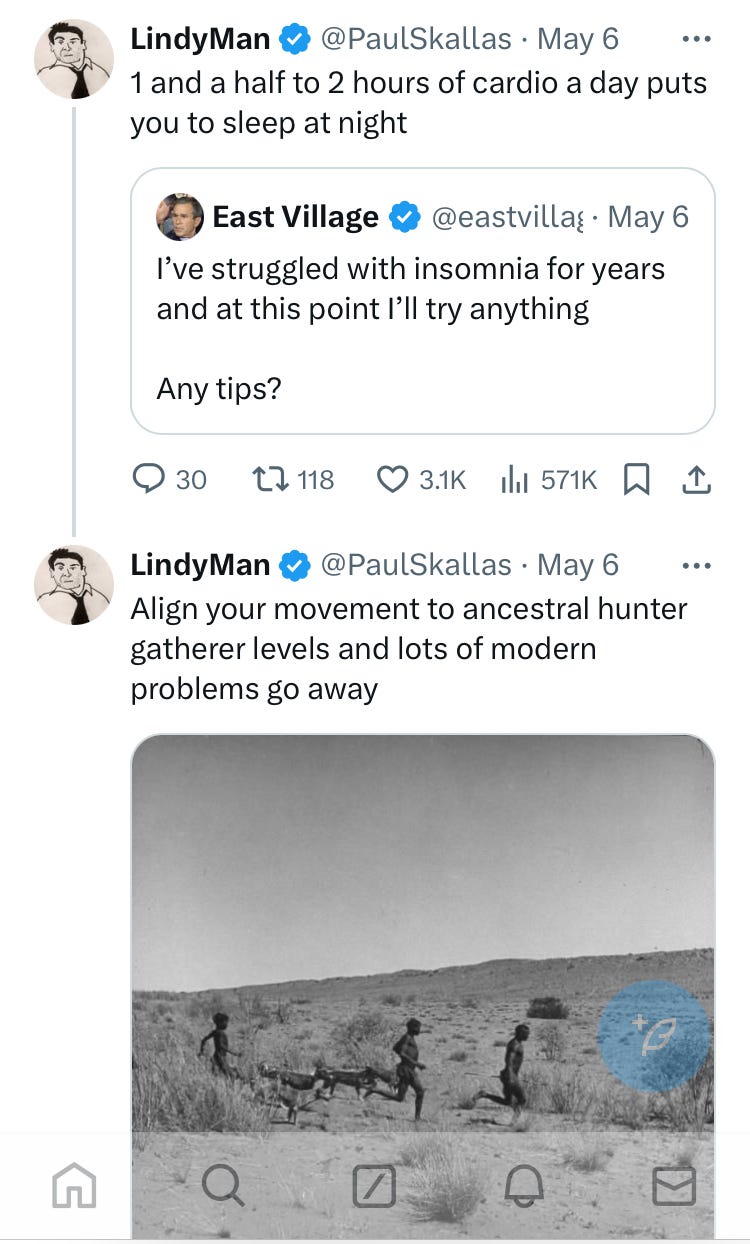
If only I could live another 250 years, then I just might get all of my sewing, quilting, embroidery, knitting, crochet, beading, and other crafting projects done! Great piece Cale.
This concept is new to me. Very interesting. I think sewing and quilting will stand the test of time as resources get scarcer and a throwaway society becomes less and less sustainable.